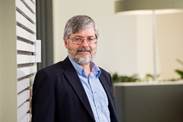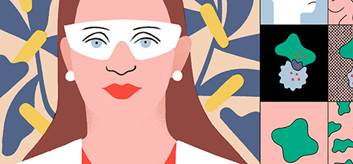Bio21 Director’s Message - 10 June 2020 - Research and Reconciliation
 Last week was National Reconciliation Week in Australia.
Last week was National Reconciliation Week in Australia.
It coincided with protests breaking out across the US and spreading across the globe, sparked by the death of an African American man George Floyd, reportedly at the hands of a white policeman. In Australia, we might feel safe to assume, ‘that could never happen here’, but we would be wrong and recent protests in our own city and across the country have highlighted discrimination experienced by our indigenous community, noting there has been 434 Aboriginal deaths in custody since 1991.
Reconciliation is as urgent as it ever was.
On Reconciliation Australia’s website ‘reconciliation’ is defined as:
“At its heart, reconciliation is about strengthening relationships between Aboriginal and Torres Strait Islander peoples and non-Indigenous peoples, for the benefit of all Australians.”
Luke Briscoe, a digital producer and Indigenous science educator, writes in a 2018 piece published by SBS for ‘National Sorry Day’:
‘But days like today — National Sorry Day / (National Day of Healing) — can serve as reminders that empathy is at the heart of all of our great steps towards reconciliation.”
Reconciliation begins when we recognise and sincerely show remorse for the harm we’ve inflicted, perhaps unknowingly or even with good intention.
Science has also caused harm. In the name of science, 19th century researchers, particularly anthropologists, took sacred ceremonial items and even remains of the deceased from Aboriginal tribes.
To mark the 250th anniversary of Captain James Cook’s first voyage to Australia in 2019, Manchester Museum became the first UK institution to return ceremonial items to Aboriginal groups. The repatriation project run by the Australian Institute of Aboriginal and Torres Strait Islander Studies (AIATSIS), said it had identified more than 100,000 sacred items in 220 institutions across the world.
Rather than being the object of research, indigenous people are being empowered to conduct their own research.
Institutions, such as the national 12-member Lowitja Institute and the University’s Poche Institute within the Faculty of Medicine, Dentistry and Health Sciences (MDHS) play a critical role in fostering indigenous health and research leaders. [Watch film about how indigenous-led research helps close ‘the gap’].
Also, it is great to see indigenous leadership within the University. Associate Professor Michael Sean Fletcher is the Assistant Dean (Indigenous) in the Faculty of Science. He is an academic in the School of Geography. You can listen to his thoughts on reconciliation in a short YouTube video here, as well as a webinar and Q&A with Early Career Researchers Zena Cumpston, Jared Field, Tegan Goulmer, Mitchell Baum last week ‘The Role of STEM in Reconciliation’.
Until recently, Professor Sandra Eades was Associate Dean (Indigenous), Faculty of MDHS, University of Melbourne. A Noongar woman from Mount Barker in Western Australia, physician, researcher and professor, she was the first Aboriginal medical practitioner to be awarded a Doctorate of Philosophy in 2003. In March this year she moved to lead the Curtin Medical School in WA.
We are also very proud to see Professor Marcia Langton AO honoured with an Officer of the Order of Australia for "distinguished service to tertiary education, and as an advocate for Aboriginal and Torres Strait Islander people” at this year’s Queen’s Birthday Honours List. Professor Langton holds the Foundation Chair in Australian Indigenous Studies at the University of Melbourne in the Faculty of Medicine. In 2016 she became Distinguished Professor and in 2017, Associate Provost.
She told the Guardian she was “very pleased to accept [the award] because it is a way of turning the tide on the historical racism and low expectations that typified an older Australia, and one which I hope we can leave behind”.
“Aboriginal and Torres Strait Islander people with higher degrees are among that small percentage of our people who have closed the gap. This is especially so for Aboriginal women with higher degrees,” she said,
“If every Australian did the right thing and delivered services – in my case education services – to Aboriginal and Torres Strait Islander people without prejudice and strived for parity in Indigenous representation in Australian education, employment and other areas, we would reach our goal of closing the gap very quickly.
During the coronavirus COVID-19 pandemic, we have seen how indigenous medical, allied health and science professionals have played their role on the front lines to keep their communities informed, healthy and empowered. Read the Pursuit piece.
A summary of a research paper about the progress made in educating indigenous medical researchers reads:
“A key site of the researcher workforce is the higher education sector. The number of Aboriginal and Torres Strait Islander Researchers has grown markedly from 2001 to 2017.
This includes:
• a five-fold increase in Masters by Research and Doctorate by Research enrolments in health;
• 619 completions of Masters by Research (207 completions) and Doctorate by Research (412 completions), over 16% of these in health fields.
• as of 2017, there were 387 staff employed at universities in research functions (22% in health research positions).”
Significant changes include more Aboriginal and Torres Strait Islander control of research processes; collaborative engagement between Indigenous and non-Indigenous researchers/organisations and shifting from a ‘deficit paradigm’ to ‘strengths-based’ focus of education and research.
We are also starting to listen and learn from Aboriginal people about the scientific knowledge held within their stories, songs and traditions, for example, to inform the way we manage fire in the Australian landscape; to understand historical climate change, as well as to interpret star constellations to recognise the seasons.
It is important to celebrate and highlight the indigenous researchers in our midst, for example, Misty Jenkins from the Walter and Eliza Hall Institute, has been included as part of the Parkville Storytelling Project that is currently displayed along Grattan Street.

Her story was written up as part of the project:
“Misty Jenkins is a descendent of the Gunditjmara nation of western Victoria, and a trailblazer in the world of science.
“She was the first person in her family to go to university, leaving her home in Ballarat to study at the University of Melbourne. After completing her PhD, she became the first Indigenous Australian to undertake post-doctoral training at both the University of Oxford and the University of Cambridge.”
“Given her experience, it’s not surprising Dr Jenkins has become an advocate for women in science, and for increasing the participation of Indigenous Australians in higher education, and in the world of science.”
As for the Bio21 Institute, we acknowledge our Institute stands on lands of the Wurundjeri people of the Kulin nation.
You can download an App called ‘Billebellary’s Walk’ that takes you to familiar places on the University campus and gives you insight into the land of the Wurundjeri people.
For example, it asks you at Stop 9 on the map, to imagine:
“A Cultural Landscape not Lost - The Townend creek originated from somewhere near the current Melbourne Cemetery, it flowed through the University site and down a shallow valley, along which Bouverie Street now runs.
Take yourself back to 1830 once again – to Billibellary’s time – and here you would have been standing on the bank of the creek watching short-finned eel that have migrated upstream.”
Informed by Bio21’s Equity, Diversity and Inclusion Committee we continuously strive to be an Institute community in which people feel welcome and supported; to remove structural barriers in our institution and unconscious biases in ourselves that discriminate against members of community as a result of their ethnic, religious, cultural background or gender.
Therefore, it is great to see organisations like Reconciliation Australia working with institutions to develop a ‘Reconciliation Action Plan.’ The University of Melbourne has committed to reconciliation and you can find the Reconciliation Action Plan here.
Since June 2010, the University’s first ‘RAP’, our Indigenous student and staff numbers have increased by 93 per cent and 296 per cent respectively since we implemented our first RAP and, importantly, their retention and success outcomes remain strong. The University is now implementing its third RAP.
In light of recent protests in the US and also the trauma sustained by indigenous people in this country, on behalf of the Bio21 community, I wish to extend our thoughts and support to the Aboriginal and Torres Strait Islander community at this time. To quote Luke Briscoe:
“As Australians —we are bound to each other’s fate. In order to achieve reconciliation, we must heal together— reconciliation is everyone’s responsibility," he said in 2005.
Michael Parker
Director, Bio21 Institute

